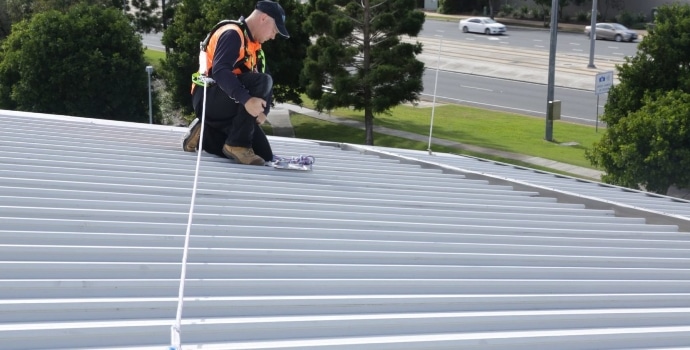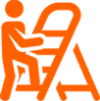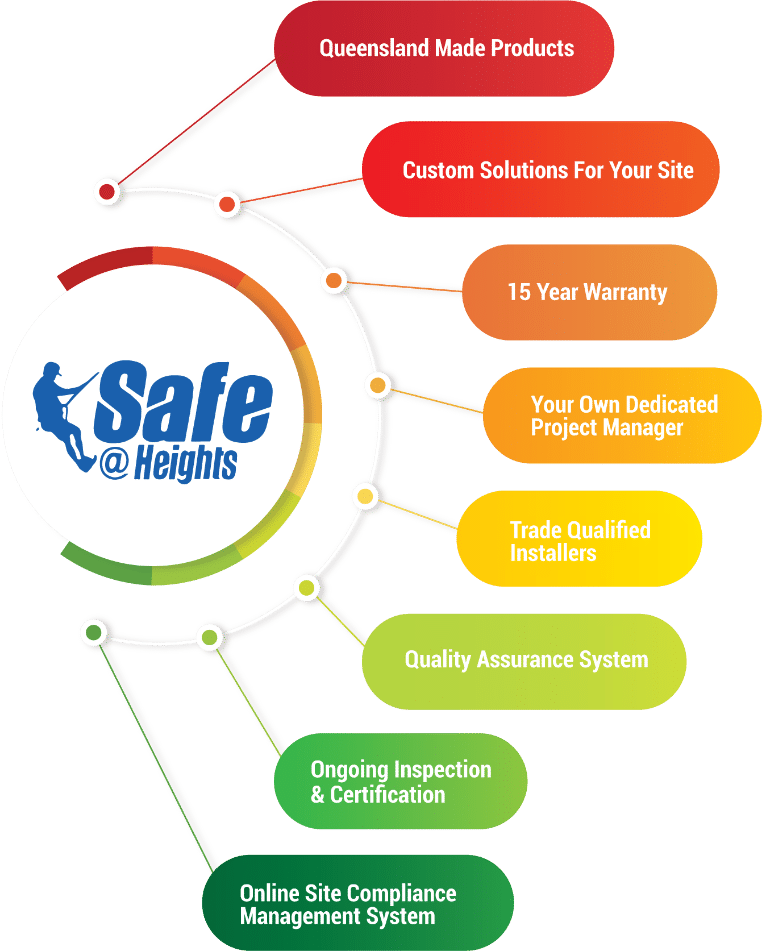A fall arrest system is any type of system that allows you to connect a harness via a rope line or lanyard, such as an anchor point, static line or rail system. A fall arrest system can be used as a fall restraint system by correct use of your PPE. To learn more about our different types of systems, please choose from the options below. Or if you are unsure of what you need, please contact us and one of our helpful team can assist you.
Industry Leading Height Safety Designs & Advice
We specialise in roof safety compliance auditing, height safety designs and installation of access and fall prevention height safety systems. We utilise our extensive knowledge of current height safety Legislation, Codes of Practice and Australian Standards to ensure that your workplace is safe, compliant and most importantly incident free.
There are many types of fall arrest systems available for working at heights safely. Which one you choose will depend upon many factors. That is why it is vital that the roof safety system is designed correctly. This means choosing the right fall arrest system product for the right application and installed in the right place. We are authorised installers for all major height safety manufacturers such as HawkPro Safety, 3M (formally Capital Safety), SAYFA Systems, Honeywell and Ferno. As part of your overall height safety design we can also provide for you roof walkways, guard railing, roof access hatches with fold down ladders and custom designed and fabricated angled ladders, cages, step type ladders and stairs.


This is a question we get asked a lot! Our recommendation for your particular requirements will depend upon the following important factors:
- Reason for accessing the area
- Type of work being conducted
- How many workers will be involved
- What skill level they will have
- Type of roof material
- Type of roof structure
- How often the system will be used.
Our fall arrest systems are of the highest quality, offering you a premium support system to assist with improving roof safety when working at heights. Our Queensland Designed and Made systems are of the highest quality and come with an industry leading 15 year warranty when part of our Certification & Safety Program.
Once all of the above roof safety factors have been taken into consideration, we can design a safe and compliant fall arrest system with the most appropriate and suitable product. Our Fall Prevention Specialists have an in-depth understanding of all current legislation and standards. We take into consideration all known hazards and risks to ensure our designs are easy to use, compliant and above all safe.
This is a great question and one that many people struggle with. Fall arrest means you are working in a position where you are at risk of a fall and having to rely upon your fall arrest system to save you. An example of this, is a worker who is attached to a static line system that is positioned 3m away from the roof edge and they are attached to the system via a 15m rope line. In this scenario the worker is able to extend his rope line so that he could fall over the edge. Where as fall restraint means that your fall arrest system is preventing you from being able to fall.
Using the same example, being in fall restraint is being attached to the static line system that is positioned 3m from the roof edge via a 2m lanyard. When attached like this, you are using a “fall arrest system” but are working in “fall restraint” because the lanyard length is preventing you from being able to fall over the edge.
So in the first example, the rope line can be extended to a length that is longer than the distance from the static line to the edge. Where as in the second example the length of the lanyard is less than the distance to the edge of the roof.
We often hear people argue that if the worker properly adjusts their rope line to be only 2m long, then they are now working in fall restraint. This is not correct and the reason for this is that they have the potential through error of extending their rope line and exposing themselves to a fall. When working in fall restraint you are wanting to remove the risk of error by taking away the adjustment.
We have information and induction videos available that show step by step how to safely work and set up your systems for both fall arrest and fall restraint. For more information please contact us.

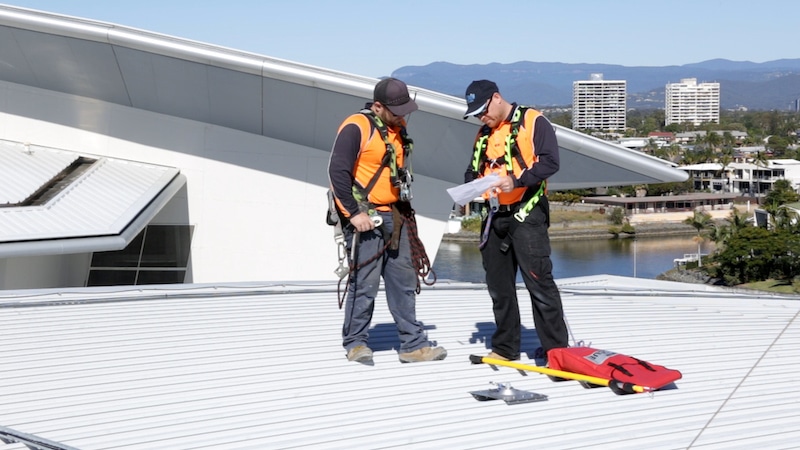
This is a question we were asked almost every time we installed a fall arrest system. Owners of the systems wanted to know what was the safest way to use the system. So we developed our height safety induction and training videos that clearly show how to use fall arrest systems safely. In doing so we developed four methods of attachment.
- Fixed fall restraint
- Adjustable fall restraint
- Fall arrest
- Constant attachment method
fall arrest systems safe at heights queensland 4
Once you understand how each method works, you are always able to work safely. Depending upon the situation, the type of being completed and proximity to the fall edge, you are able to choose the most appropriate and safe method to use. To read more about our four attachment methods click here Safe Attachment Methods.
Are you interested in any of our other tailored roof safety products? We also specialise in the installation of roof access ladders, roof walkway systems, roof anchor points and much more. For more information about our range of fall arrest systems, please get in touch with our team. We’re always more than happy to assist you with your enquiries and provide reliable advice to help you make an informed decision.
How to Work Safely on a Roof
We have a complete range of instructional videos that take you through step by step on how to work safely at heights. Below is taken directly from our Introduction to Height Safety video and provides clear guidelines on how to move around a roof safely. For more information about this and our great range of videos please contact us.

The Work Health and Safety Regulation defines working at heights as, “a fall by a person from one level to another that is reasonably likely to cause injury to the person or any other person.”.
There is no minimum height that is considered safe. If you or anyone else is exposed to a fall which is likely to cause an injury, you must take immediate action to control the risks.
It is vital that when working at heights that you continually evaluate the working environment around you to ensure that you are not exposing yourself or others to a fall risk.
It is your responsibility to keep yourself safe.
If at any time you feel unsafe or feel that you are being exposed to an uncontrolled fall risk, you are charged with a duty to
- Stop work immediately
- Move away from the fall hazard
- Ensure that no one else is being exposed to the fall hazard and
- Notify your supervisor
Do not recommence work until all risks associated with the fall hazard have been properly controlled and the new control measures documented in your SWMS.
Prior to commencing any working at heights related activities, you should obtain a Permit to Work at Heights.
When completing the Permit to Work at Heights, all workers must sign a declaration agreeing that they will not at any time work outside of the site safety guidelines and that you will follow all instructions given by the nominated supervisor.
The Traffic Light Safety Method
When moving around and working on a roof you must follow the Traffic Light Safety Method. This method has been developed to provide clear guidelines that will help keep you safe when working at heights. Under no circumstances can you breach any of these rules.
The traffic light safety method is an efficient system that allows you to quickly evaluate the fall risk on a roof. By following this principle you will always be protected from a fall.
There are three defined zones that are distinguished by the use of the colours, green, orange and red.
The Green Zone is any area where you are further than 4m away from an unprotected fall edge and the roof pitch is under 15°. In the Green Zone you may choose to work unrestrained. When in the green zone you are not exposed to an immediate fall risk.
The Orange Zone is between 2m and 4m from an unprotected fall edge and the roof pitch is under 15°. The Orange Zone is considered a medium to high risk area and it is recommended that you employ fall controls when working in this area. If you choose to enter this area without controls you may only do so for short periods of time. For example when work will take less than 5mins. When in this zone you must be aware of your position in relation to the potential fall zone and always face the fall edge. If your task will take longer than 5mins you must employ fall controls in accordance with the work being conducted. When working in the orange zone, you must have a spotter at all times to ensure you are safe.
The Red Zone is within 2m of an unprotected fall edge. This is a high risk area that cannot be entered for any reason without first employing adequate controls in accordance with your Permit to Work and SWMS. If your controls include the use of a fall arrest system, you must ensure that there is rescue equipment at the work location ready for immediate deployment and that there is at least one trained rescue person present. The rescue person must never be the one working in fall arrest and at no point can they put themselves in a position where they may fall. They must remain inside the green zone.
It is a requirement that a Supervisor is nominated and this person’s name be recorded on the Permit to Work at Heights. It is the responsibility of the Supervisor to ensure that any person working at heights and using safety systems has the required information, training and experience to use the systems safely. They must also oversee the work and ensure that all workers conduct their work safely and follow our site safety rules. To be nominated as supervisor you must declare that you have sufficient training and experience for this role.
Your safety when working at heights is the number one priority. Please remember the four principles of height safety
- Always follow the Traffic Light Safety Method
- Never expose yourself or others to an uncontrolled fall hazard
- Constantly evaluate your surroundings to ensure you are safe, and
- Never work outside of your Permit to Work and SWMS
For further information on our range of fall arrest systems including our fall prevention designs please contact us.
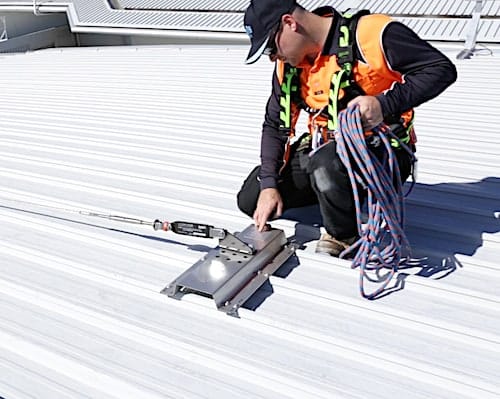
Request a Quote
Get in touch




